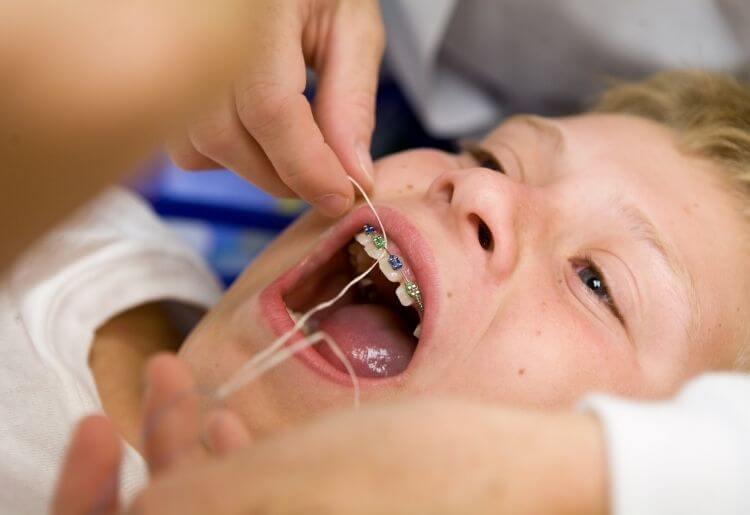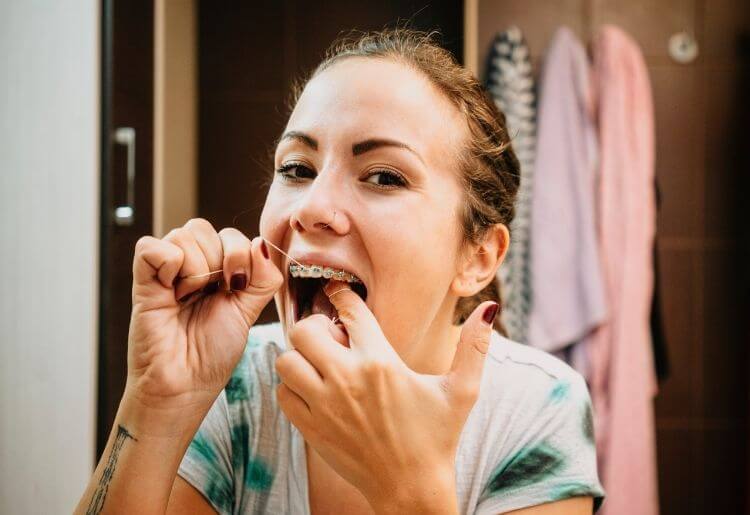If you’re wearing braces, it’s a good idea to floss, as food can easily become lodged in the different parts and cause damage and bad breath.
Of course, this isn’t a problem if you’re wearing invisible aligners, as you can simply remove them when brushing your teeth. If you have traditional braces, though, you’ll want to follow the steps below to floss properly with braces.
Why flossing is so important
When you’re wearing fixed braces, a large portion of your tooth enamel is covered up by brackets. You’ve also got wires and elastic bands (known as ligatures). That means an abundance of nooks and crannies where food particles can get trapped. Of course, if you opt for a clear aligner system such as NewSmile or AlignerCo, this problem doesn’t exist since you remove the aligners to brush and floss your teeth as usual.
Food lodged around brackets or trapped between the wires and teeth attracts bacteria, which is partly what makes up plaque, the sticky film that coats the teeth. Bacteria produce acids that can harm or weaken your teeth, ultimately leading to tooth decay and cavities. Trapped food can also lead to another unpleasant side effect - bad breath!
Brushing helps remove bacteria and food that stain teeth and cause tooth decay, but it simply isn't possible to reach those nooks and crannies with a toothbrush the way you can with dental floss. This makes flossing one of the most important things you can do for your teeth.
How to floss with braces
Today, there are many different options for flossing your teeth. We explore these below.
Traditional flossing
Flossing the old-fashioned way can be challenging with braces, but it’s not impossible. Trust us when we say that with a little patience you’ll soon get the hang of it. If you're committed to this method, then buy yourself some waxed floss.
Start by brushing your teeth. When wearing fixed braces, it’s essential to spend more time on each tooth. Brush as thoroughly as possible for 3-5 minutes using a soft toothbrush and fluoride toothpaste. Then follow with a mouthwash to add an extra layer of cleanliness. Now it’s time to floss as follows:
You want to cut a piece of floss that’s around 18-24 inches long.
Wrap the ends around your index fingers to get a good hold of the floss.
Then thread the floss between the main wire and your teeth.
Press the floss between the two teeth, slide it up and down, all around the sides, and into the movable gum tissue, to remove any plaque build-up and food particles.
Curl the used floss around your finger to prevent putting germs back into your mouth.
Move on to the subsequent teeth and repeat the process.
Traditional dental floss comes in two versions: waxed and unwaxed. The waxed version is slightly thicker than the unwaxed version, but the latter is more likely to get caught on your braces. We recommend Superfloss from Oral B which has a stiffened end to get underneath dental appliances and a broad spongy length for cleaning in wide spaces and around brackets.
If the traditional method of flossing seems a little too fiddly, you could try a floss threader to speed things up.
What is a floss threader?
Floss threaders are small plastic tools designed to help pull the floss behind braces more easily. The process is similar to traditional flossing but with a couple of differences. Instead of positioning the floss between your teeth, guide it through the eye of the floss threader before inserting the point of the plastic needle under the wire of your braces. This enables you to pull the floss from the other side to get into those tricky hard-to-reach areas.
Using a floss threader will shorten your dental care routine by several minutes, giving you an extra 5 minutes in bed in the morning :) You can buy floss threaders from most pharmacies or supermarkets in the dental care aisle. Your orthodontist or dentist may even have a couple of samples you can try out before buying a full bag.

Dental tape
Some people find traditional flossing to be too painful, particularly if they haven't flossed regularly before getting braces. Unhealthy gums are prone to bleed and swell when you first start flossing them. Given time, the gums will stop bleeding and flossing will feel more comfortable.
You may want to consider flossing with dental tape while your gums are sensitive. With its flat surface, dental tape slides between the teeth easier and is less likely to snap against the gums than dental floss. Use it in the same way as dental floss
Interdental brushes
These small-bristle brushes are an excellent addition to your arsenal of dental care products. With an angled head and long handle, they’re perfect for removing food particles and plaque between the teeth that a regular toothbrush can’t reach. Even better, they’re available in different widths to suit the size of the gaps between your teeth. You should never force a brush between your teeth. If it’s too large, swap it out for a smaller size.
Top tip: You may need more than one size. Your dentist can help you choose a suitable size but if in doubt, you can always opt for an interdental mix-pack to find the best size for you.
All you do is place the interdental brush between the teeth and gently move the full length back and forth a few times to dislodge any debris. It’s important to only brush with water since toothpaste can be abrasive. Be sure to change the brush when the filaments show signs of wear.
Research shows that interdental brushes are kinder to the gums than floss because the bristles don’t cut into the gums as floss can. It’s also thought that the bristles may be more effective at removing bacteria in the interdental area than dental floss.
How to floss with braces using an oral irrigator
If you're struggling to floss with braces on your teeth, an oral irrigator also known as a water flosser or pik could be a good option. A water flosser doesn't mean ditching your toothbrush and dental floss. You still need to brush your teeth twice a day, but you can use a water flosser before brushing or after - it’s your choice.
How to use a water flosser:
Fill the reservoir with lukewarm water
Put the flosser tip in your mouth
To avoid mess, lean over a sink
Turn on the machine and it’s time to clean
Hold the handle at a ninety-degree angle to your teeth and spray
The water will steadily stream out, cleaning between your teeth
Start at the back and steadily work around the mouth, focusing on the top, back, and front of the teeth, the spaces between the teeth, and the gumline
The process should take 2-3 minutes
Kids and teens with braces may find it easier to keep their teeth clean with a water flosser than traditional flossing. It’s also useful if you suffer from arthritis or have other problems using your hands. Ask your dentist if it’s worthwhile investing in a water flosser, such as a Waterpik.
Conclusion
When you're wearing braces, it’s more important than ever to floss for the simple fact there are more nooks and crannies where food can get trapped and attract bacteria. Acids from bacteria form plaque which causes tooth decay and cavities if it’s not removed. It’s important for the health of your teeth and your wallet to save you spending more money on fixing problems that flossing could have avoided.
If you're in need of getting braces, consider getting invisible aligners, which make the flossing process much simpler.
